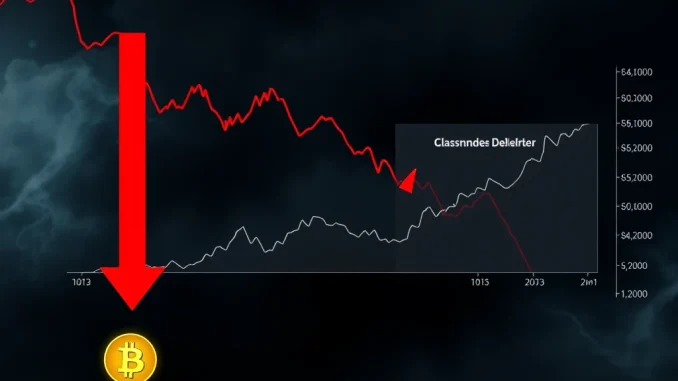
Is the crypto winter biting harder than we thought? New data from Glassnode is painting a concerning picture of the Bitcoin market. It appears the recent sell-offs are no longer just shaking out short-term speculators; even seasoned mid-term holders are feeling the pain. Let’s dive into what Glassnode’s latest report reveals about the deepening market capitulation and what it means for your Bitcoin portfolio.
Unveiling Bitcoin Losses Across Mid-Term Holders
For a while, it seemed like the Bitcoin market was weathering the storm, with mostly short-term holders reacting to volatility. However, Glassnode’s on-chain analysis, shared on X, throws a spotlight on a shifting trend. The report highlights a significant increase in Bitcoin losses being realized by mid-term holders – those who have held their coins for 3 to 6 months. This is a crucial shift because mid-term holders are often seen as having stronger conviction than short-term traders, suggesting a broader and potentially more serious phase of capitulation.
Let’s break down the numbers to truly understand the scale of this change:
- February 27th: Bitcoin losses realized by mid-term holders were a mere 0.8% of the total losses. This suggests that at this point, the sell-off was primarily driven by newer market participants.
- April 7th: Fast forward just over a month, and this figure has skyrocketed to 19.4%! This nearly 20-fold increase indicates a dramatic shift. Mid-term holders are now a significant contributor to the overall selling pressure and are increasingly realizing losses on their Bitcoin holdings.
This surge in losses among mid-term holders is a key indicator that the current market downturn is intensifying. It signifies that the pressure to sell is extending beyond the typical short-term volatility reactions and is now impacting investors with a slightly longer-term perspective.
Why Are Mid-Term Holders Feeling the Pressure?
What’s driving this increased selling pressure among mid-term holders? Several factors could be at play:
- Prolonged Market Correction: The crypto market has been experiencing volatility and corrections for a while now. What initially might have seemed like a temporary dip could be stretching into a more sustained downturn. This prolonged uncertainty can erode the confidence of even mid-term holders, leading them to cut their losses.
- Broader Economic Concerns: Macroeconomic factors, such as inflation, interest rate hikes, and geopolitical instability, can significantly impact investor sentiment across all markets, including crypto. These external pressures can make even those with a longer-term outlook reconsider their risk exposure and investment strategies in assets like Bitcoin.
- Fear of Further Declines: As the price of Bitcoin fluctuates and potentially trends downwards, the fear of missing out (FOMO) can turn into the fear of further declines. This fear can be particularly potent for mid-term holders who might have entered the market at higher prices and are now seeing their profits diminish or turn into losses.
Deepening Market Capitulation: What Does It Mean?
The increase in Bitcoin losses for mid-term holders is a strong signal of deepening market capitulation. But what exactly does ‘capitulation’ mean in the context of cryptocurrency markets?
Market capitulation refers to a point in a market downturn where investors, often out of fear or desperation, give up on the prospect of prices recovering soon and sell their assets. This selling pressure can be intense and often marks a bottom in the market cycle, as most of the ‘weak hands’ have been shaken out.
Here’s why the rising share of losses from mid-term holders suggests we might be in or moving towards a deeper phase of capitulation:
- Shifting Investor Sentiment: When mid-term holders start capitulating, it indicates a broader shift in investor sentiment. It’s no longer just short-term traders reacting to noise; it’s a sign that a more significant portion of the market is losing faith in a quick recovery.
- Potential for Price Bottom: Historically, periods of intense capitulation have often preceded market bottoms in crypto. While it’s impossible to predict the exact bottom, this data from Glassnode suggests that we might be approaching a point where selling pressure could exhaust itself.
- Opportunity for Long-Term Investors?: For those with a long-term investment horizon and strong conviction in Bitcoin, periods of capitulation can present potential buying opportunities. As weaker hands sell, assets can become undervalued, offering a chance to accumulate Bitcoin at potentially lower prices.
Navigating the Current Bitcoin Landscape: Actionable Insights
So, what should you do with this information about increasing Bitcoin losses and deepening market capitulation? Here are some actionable insights:
- Stay Informed: Keep a close eye on market data and analysis from reputable sources like Glassnode. Understanding on-chain metrics can provide valuable insights into market trends and investor behavior.
- Review Your Risk Tolerance: Market downturns are a good time to reassess your risk tolerance and investment strategy. Ensure your portfolio allocation aligns with your comfort level and long-term financial goals.
- Consider Dollar-Cost Averaging (DCA): If you believe in the long-term potential of Bitcoin, consider using a dollar-cost averaging strategy. This involves investing a fixed amount of money at regular intervals, regardless of the price, which can help mitigate the risk of trying to time the market bottom.
- Don’t Panic Sell: While seeing red in your portfolio can be unsettling, avoid making emotional decisions. Panicking and selling during periods of capitulation can lock in losses and prevent you from benefiting from potential future recoveries.
Conclusion: Is This the Depths of the Bitcoin Capitulation?
Glassnode’s data revealing increased Bitcoin losses among mid-term holders is undoubtedly a significant development. It signals a deepening phase of market capitulation and suggests that the current downturn is impacting a wider range of investors. While market capitulation can be unsettling, it also historically presents opportunities. By staying informed, managing risk, and maintaining a long-term perspective, you can navigate these turbulent times and position yourself for potential future market recoveries in the dynamic world of cryptocurrency.



